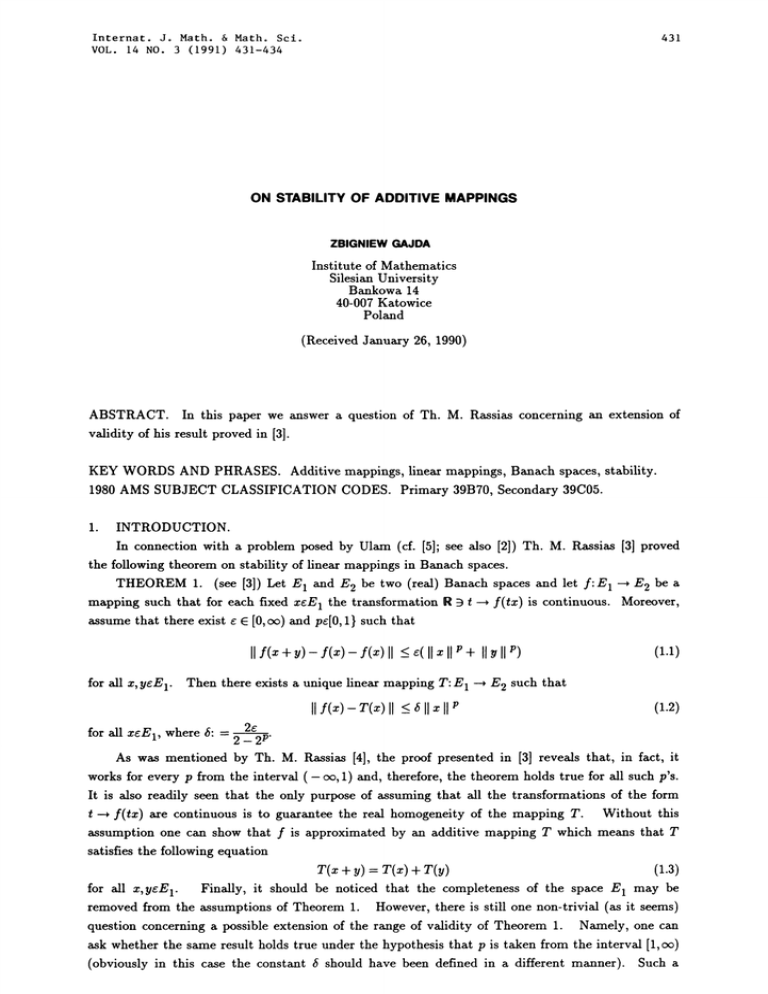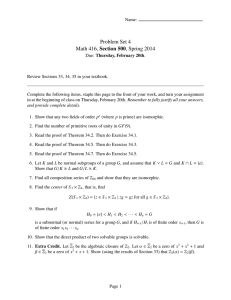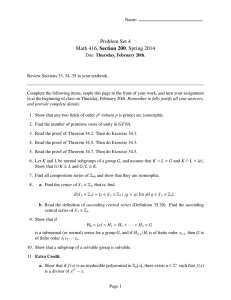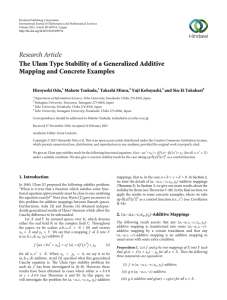Document 10442894
advertisement

Internat. J. Math. & Math. Sci.
VOL. 14 NO. 3 (1991) 431-434
431
ON STABILITY OF ADDITIVE MAPPINGS
ZBIGNIEW GAJDA
Institute of Mathematics
Silesian University
Bankowa 14
40-007 Katowice
Poland
(Received January 26, 1990)
ABSTRACT. In this paper we answer a question of Th. M. Rassias concerning an extension of
validity of his result proved in [3].
KEY WORDS AND PHRASES. Additive mappings, linear mappings, Banach spaces, stability.
1980 AMS SUBJECT CLASSIFICATION CODES. Primary 39B70, Secondary 39C05.
1.
INTRODUCTION.
In connection with
problem posed by Ulam (cf. [5]; see also [2]) Th. M. Rassias [3] proved
the following theorem on stability of linear mappings in Banach spaces.
E2 be a
THEOREM 1. (see [3]) Let E and E2 be two (real) Banach spaces and let f: E
mapping such that for each fixed xeE the transformation R
f(tx) is continuous. Moreover,
assume that there exist e E [0, oo) and pc[O, such that
a
f( / v)- f()- f()II
-< (
p/
for all z, yeE 1. Then there exists a unique linear mapping T: E
f()- r()II
for all
zeE1, where :
-<
p
--,
P)
(1.1)
E2 such that
(-)
2e
2_2 p"
As was mentioned by Th. M. Rassias [4], the proof presented in [3] reveals that, in fact, it
works for every p from the interval (- oo, 1) and, therefore, the theorem holds true for all such p’s.
It is also readily seen that the only purpose of assuming that all the transformations of the form
t--, f(tx) are continuous is to guarantee the real homogeneity of the mapping T.
Without this
assumption one can show that f is approximated by an additive mapping T which means that T
satisfies the following equation
T(x + y) T(x) + T(y)
(1.3)
for all x,yE 1.
Finally, it should be noticed that the completeness of the space E may be
removed from the assumptions of Theorem 1. However, there is still one non-trivial (as it seems)
question concerning a possible extension of the range of validity of Theorem 1. Namely, one can
ask whether the same result holds true under the hypothesis that p is taken from the interval [1,oo)
(obviously in this case the constant should have been defined in a different manner). Such a
Z. GAJDA
432
problem was raised by Th. M. Rassias during the 27th International Symposium on Functional
Equations which was held in Bielsko-Biala, Katowice and Krokow in August 1989. The goal of the
present note is to give a complete solution to this problem.
2.
MAIN RESULTS.
in its original form
First, let us realize why the proof of Theorem
p
(see [3]) does not work for
_> 1. The fundamental role in this proof is played by the sequence
{n
ne}
f(2nx)"
(2.1)
which, under the assumptions of Theorem (in fact as long as pc(- cxz, 1)) is convergent for each
fixed xeE 1. Then T: E
E 2 defined by the formula
T(z):
=nlim
n
f(2nx),
(2.2)
:reEl
is the desired linear mapping approximating f. The argument ensuring the convergence of
sequence (2.1) is no longer valid when p becomes greater or equal to 1, so in order to carry the
proof over to this case, one has to change the argument itself or the definition of the mapping T. It
turns out that, for p > 1, the latter modification of the proof is possible. As a result we obtain the
following extension of Theorem 1:
THEOREM 2. Let E and E2 be two (real) normed linear spaces and assume that E2 is
E2 be a mapping for which there exist two constants e E [0,o) and
complete. Let f:E
p E R\{1 } such that
f(x + 9)- f(x)- f(9)11 < e(
p
x
+
for all z, 9eE 1. Then there exists a unique additive mapping T: E
f(z)- T(x)II
for all
9
P)
(2.3)
E 2 such that
<6
(2.4)
xcE1, where
2
for P < 1,
6= 2-2P
2
2P-2
Moreover,
is for each x q
for p > 1.
f(tx) is continuous, then the mapping T is
E the transformation R 9
linear.
PROOF. In view of what has been said
so
main innovation in comparison with the case p
far, it remains to consider the case p > 1. The
< 1 consists in defining the mapping T by the
formula
T(x)"
=nlim 2nf(#),
(2.5)
xcE
(2.2). Obviously, one has to verify the convergence of the sequence occurring on the
right-hand side of (2.5).
Putting in place of z and y in inequality (2.3), we obtain
instead of
f(x)- 2
for all x
f()II
21 Pc
<2
E 1. Hence for each n and every x El,
x p
we have
f()- 2f(2-) + + 2n 11 f(2n X 2f(#)I]
<21 P[[xlIP+2.21 Pll[[P+...+2 n 1.21 Pll2n_l[[ p
f(x)- 2n f(#)II < f(x)- 2f()II + 2
(21
p
+ 22(1 p) + + 2n(1
p))
z p
433
STABiLiTY OF ADDITIVE MAPPINGS
where $ is the sum of the following convergent series:
c
Z 2-(1-P)
2
2P_2
Now, fix an zcE and chse arbitrary m,n such that
2a
2mf()- 2"f()[[
2m
> n. Then
-nf(2-n "#)- f()II
,
2"(1 p)g
2"
.
m
which becomes arbitrarily smM1 as n
On account of the completeness of the space E2, this
implies that the sequence
n} is convergent for each z E 1. Thus T is correctly defined
in (2.6).
by (2.5). Morver, it satisfies condition (2.4) which results on letting,
=d by
in (2.3) =d then multiplying both sides of the resulting
FinMly, replacing z by
inequMity by 2 n, we get
{2"f()"
2nf()- 2nf()- 2nf()II
2n(X P)(
+
P),
for z,V E E 1. Since the right-hand side of this inequality tends to zero as n cx, it becomes
apparent that the mapping T defined by (2.5) is additive.
The proof of the homogeneity of T (under the supplementary assumption that
f(tz) is
continuous for each z E El) needs no essential alterations in comparison with the case p < 1. It is
also clear what has to be changed in the proof of the uniqueness of T.
Theorem 2 leaves the case p
undecided. This is not a mere coincidence. It turns out
that 1 is the only critical value of p to which Theorem 2 can not be extended. In fact, we shall
show that e > 0 one can find a function f:R R such that
f(x + y)- f(x)- f(Y) < e(lx
+ Yl)
(2.7)
for all x, yeR, but, at the same time, there is no constant 6 [0,cx) and no additive function
T:R R satisfying the condition
for all zeR..
(2.8)
If(x)- T(z) < 6lz
.
This singularity is illustrated by the following:
First we define a function
EXAMPLE. Fix e > 0 and put/:
(x):
x
f(z):
R by
for [1,
for xe 1,1),
zR. Therefore,
Evidently, is continuous d I(z)
defined by the formula
:R
a function
f:
R is correctly
ff(2n)
n:0
2n
Since f is defined by means of a uniformly convergent series of continuous functions,
continuous. Moreover,
If(z)l <
We are going to show that f satisfies (2.7).
n=0
-2,
x.
f
itself is
434
Z. GAJDA
0, then (2.7) is trivially fulfilled. Next assume that 0 <
exists an Ne such that
If x
y
ne, 12u-l<,
]x[ + [y[ < 1. Then there
12N--(,+U)I--<ZU--(II+IUl)<,
IN-luI<a
wi
implies that for each n {0,1, N -1} the numbers 2nz, 2ny and 2n(z + y) remain in the interval
(- 1,1). Since is linear on this interval, we infer that
(2"( + u)) (2") (2"u) o
for n
0,1,
N- 1. As
a
result, we get
(Ixl + lyl)
Finally, assume that
n=N
(2n(x + y)) (2"x) (2ny)
2"(Ixl + lYl)
[x[ + ]y[ > 1. Then merely by virtue of the boundedness of f we have
f(x + y)- f(x)- f(r) <
6#
Il+lul
e.
Thus we conclude that f satisfies (2.7) for all real x and y.
Now, contrary to what we claim, suppose that there exist a ( [0, oo) and an additive function
T:R --, R such that (2.8) holds true. Hence, from the continuity of f it follows that T is bounded
on some neighbourhood of zero. Then, by a classical result (see e.g. [1], 2.1.1., Theorem 1) there
exists a real constant c such that
T(x) cx, x
Hence,
which implies that
On the other hand,
from the interval
such an x we have
choose an Ne[ so large that Np > g +
1)’ we have 2nx (0,1) for each n {0,1
we can
(0,
1
2N
f(x)>
x
n=O
(2nx)
2n----
n=O
which yields a contradiction. Thus the function
Theorem 2 fails to hold for p 1.
[x[.* Then picking out an z
N 1}. Consequently, for
F2nz
Ixl,
n-=Nu>6+
f
provides a good example to the effect that
REFERENCES.
1.
2.
3.
4.
5.
ACZEL, J. Lectures o__n Functional Equations and their Applicatio.ns, Academic Press, New
York- San Francisco- London, 1966.
HYERS, D.H. On the stability of the linear functional equation, Proc..Nat. Acad. Sci.,
U.S.A., 27 (1941), 222-224.
RASSIAS, TH. M. On the stability of the linear mapping in Banach spaces, Proc. Amer.
Math. Soc. 72 (1978), 297-300.
RASSIAS, TH. M. Communication, 27t.___h.h International Symposium on Functional Equations,
Bielsko-Biala, Katowice, Krokow, Poland, 1989.
ULAM, S.M. Problems in modern mathematics, Chapter VI, Science Editions, Wiley, New
York, 1960.








